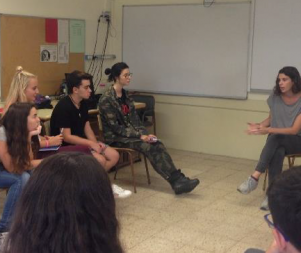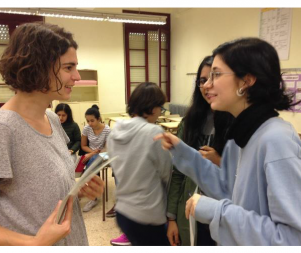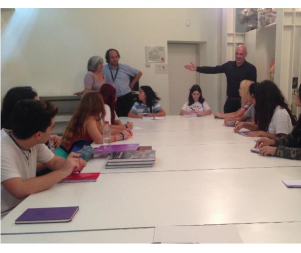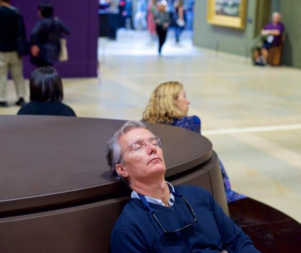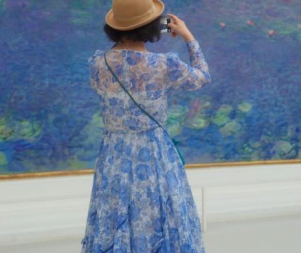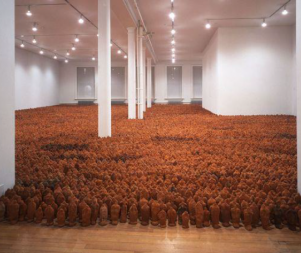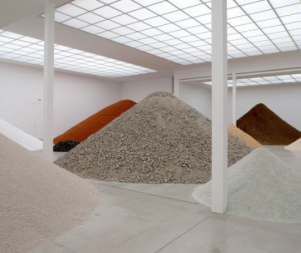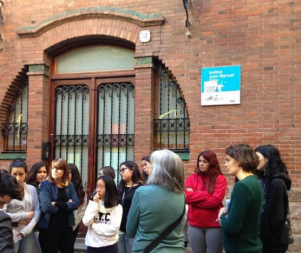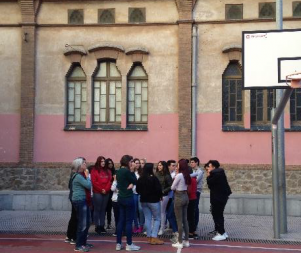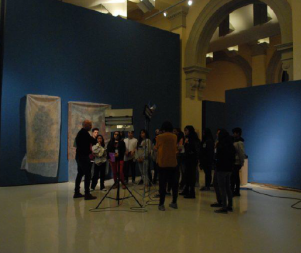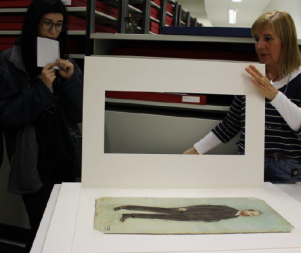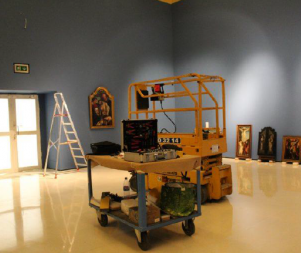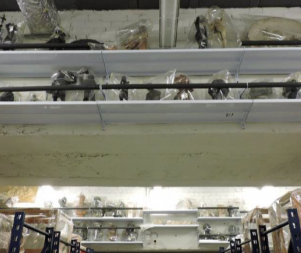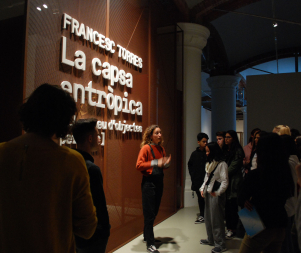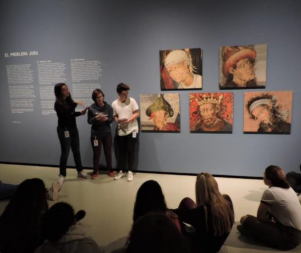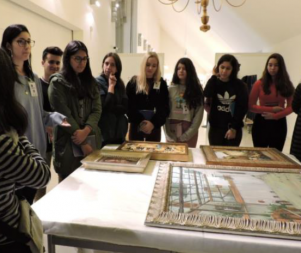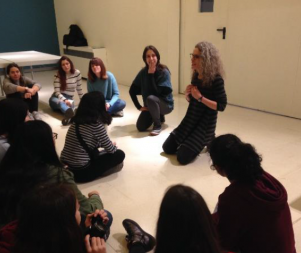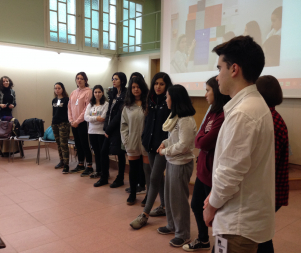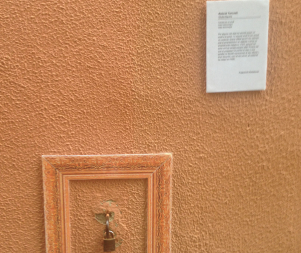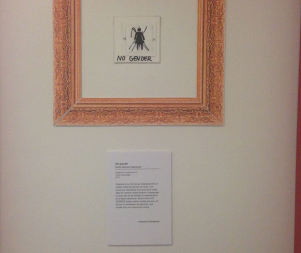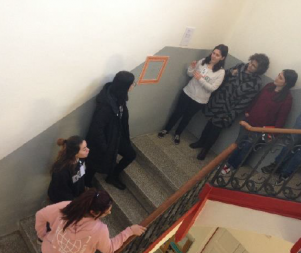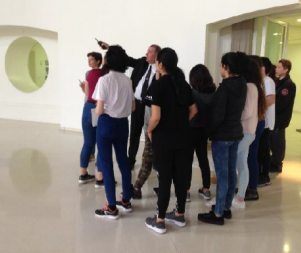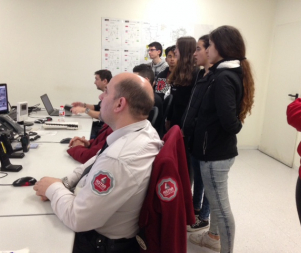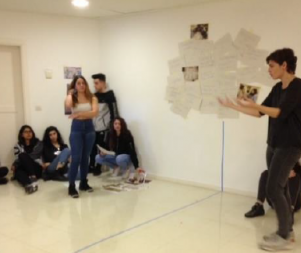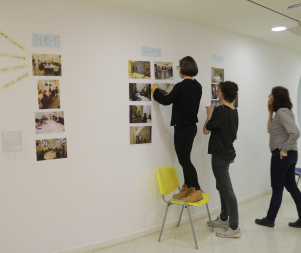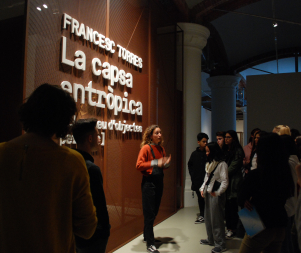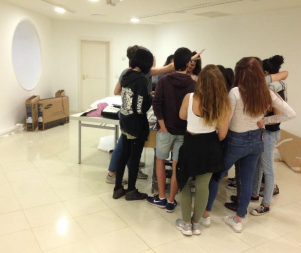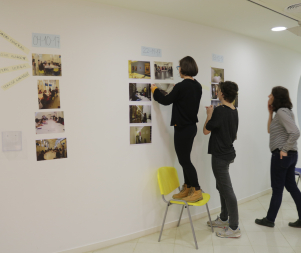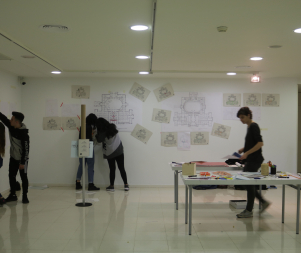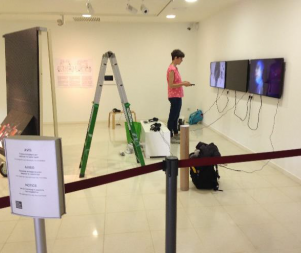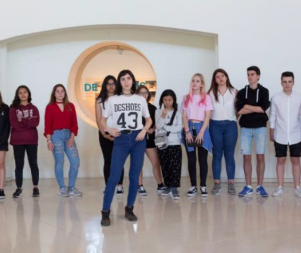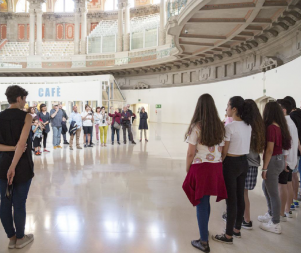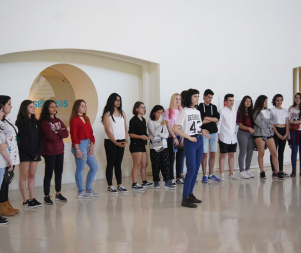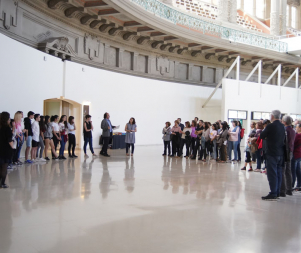- 14th EDITION 2022 / 2023
- 13th EDITION 2021 / 2022
- 12th EDITION 2020 / 2021
- 11th EDITION 2019 / 2020
- 10th EDITION 2018 / 2019
- 9th EDITION 2017 / 2018
- 8th EDITION 2016 / 2017
- 7th EDITION 2015 / 2016
- 6th EDITION 2014 / 2015
- 5th EDITION 2013 / 2014
- 4th EDITION 2012 / 2013
- 3rd EDITION 2011 / 2012
- 2nd EDITION 2010 / 2011
- 1st EDITION 2009 / 2010
Mariona Moncunill IN RESiDENCE at the School Juan Manuel Zafra
FIRST CONTACT WITH THE ARTIST AND THE NATIONAL ART MUSEUM OF CATALONIA (4/10/17 i 11/10/17)
The pupils researched a little into the work of Mariona Moncunill before meeting her, and thought about questions to ask her on the artist’s first day at the school.
During the second week of the residence, having agreed with the group to focus their research on the institution of the museum, the first visit was organised. The pupils were welcomed to the museum by the education team, the head of the mediation department, Lluís Alabern, and the director of the museum, Pepe Serra. The pupils expressed many doubts and queries during this first meeting, on such subjects as the conservation of the works, the maintenance of the building, etc. The artist then invited small groups to take a free exploration of the rooms, looking at anything that attracted their attention, not just artworks.
Based on this visit and plans of the museum, the pupils tried to remember the spaces they had explored and to draw the routes that they had followed.
ARTISTS OF REFERENCE WHO HAVE WORKED ON THE THEME OF THE MUSEUM
Mariona introduced the group to examples of contemporary artists who had worked on some theme related to museums. For instance, the likes of Thomas Streuth and Stefan Draschan, who created photographic series on visitors and their attitudes in this setting and before artworks, Anthony Gormley, whose installations alter museum itineraries, and Lara Almarcegui’s meditations on the materiality of spaces as she converts all materials into powder.
THE ROLES ARE REVERSED: GUIDED TOUR OF THE SCHOOL (15/11/2017)
In reaction to their first visit to the museum, the pupils organised a guided tour of the school for the museum staff. Responding to Mariona’s challenge to design a visit that took the concept of the guided tour to the limit, they prepared a performative narrative on the school in cooperation with some of the participating teachers.
A DAY AT THE NATIONAL MUSEUM: MUSEUM ORGANISATION AND WORKS IN STORAGE (22/11/2917)
On this second visit, the group used the fact that the museum was then working to install the new presentation of the Renaissance and Baroque rooms to talk to the head of museography at the museum, Lluís Alabern, about what is involved in such an operation: the distribution of the works; decisions about design and museographic discourse, etc. The group also saw works in storage: large paintings and paintings on stone with Jordi Casanovas; and drawings and engravings with Mercè Saura. One of the aims of the visits was also to meet as many personnel involved the work of the museum as possible.
THE NATIONAL MUSEUM SEEN BY CONTEMPORARY ART:
FRANCESC TORRES: “LA CAPSA ENTRÒPICA” [THE ENTROPIC BOX] (13/12/17)
MONTSE CARREÑO AND RAQUEL MUÑOZ: “LAS CAJAS CHINAS” [THE CHINESE CASES] (24/1/17)
Coinciding with the residency, the museum was hosting an exhibition curated by the artist Francesc Torres (La capsa entròpica. El museu d’objectes perduts, 2010/17-14/1/18) [The Entropic Box. The Museum of Lost Objects], a meditation on the intersection between history and culture, between the conservation and destruction of art and the nature of museums. This thought-provoking, critical approach to the institution and its objects provided a very useful starting point for Mariona Moncunill, and a good example to begin a process of thinking about the museum. The guided visit to the show was given by the educator Júlia Llull.
Similarly, it was decided that it would be to introduce the pupils to the project Las cajas chinas [The Chinese Cases], in which Montse Carreño and Raquel Muñoz meditate on the role of the museum regarding copies of artworks. A case containing four fake works lost during the Spanish Civil War and copied in a town of China devoted entirely to this practice served to suggest to the pupils a project that was linked to the museum from another perspective, to the point of placing the very existence of the institution in question.
MICRO-PROJECT: “FRAME AND WALL NOTES”
After several visits to the museum, Mariona Moncunill proposed a small project related to aspects of museography that the group had discovered in these outings. The proposal was to search at the school itself among nooks and crannies, cracks, drawings on the wall, imperfections, etc., for elements that for some reason they would like to highlight. These they would mark out with a frame and wall notes like those they had seen at the museum. To help them in this task, the met the designer who created the wall notes at the museum, Mireia Planas (12/13/17). Mireia told the group what basic elements were, and what her work entailed, as well as showing them some examples.
Subsequently, the pupils installed the aforementioned frames and accompanying wall notes in spaces both inside and outside the school. This alerted the other pupils and teachers to Mariona Montunill’s artist residency, and the chance was taken to organised guided tours on the day of the meeting to present the IN RESIDENCE project to all the teachers (6/2/18).
GRAND FINALE: SELECTION OF THE THEME, PROPOSAL AND PREPARATIONS FOR THE NIGHT
In the final stage in the project, the pupils were introduced to the museum security team and for the first time entered the control room from where all the security cameras on the site are monitored. (7/3/2017)
Beginning in March, the group and the artist were able to use the EducArt space, where they had been invited to present the final project. As the pupils themselves note in the blog, arranging all the materials and installed them in a white space served to “put everything we have done so far in order, organise our ideas and check what we have achieved so far”.
This act of arranging their work and reviewing their ideas revived the idea of spending a night at the museum. This activity was described as a strategy to find out about the people who work there. The group requested permission from the museum to do this, and began to sketch out the actions that they would carry out there over the course of the night.
INSTALLATION AND PRESENTATION OF THE PROJECT DE SIS A SIS
After this experience, all the materials generated were brought together: photographs of the actions, videos and audios, to begin to make a selection and take decisions as to how to present the actions and what physical elements were required.
Finally, De sis a sis [From Six to Six] took the form of a selection of photos from that night, three videos that summarised their accompanying three rounds made by security personnel, a device to hear the recordings made during the night and a cart used to transport artwork, accompanied by a photograph of a cleaner’s cart.
The project was presented to the public on May 2, attended by all the pupils and teachers and the school management team. The presentation was introduced by the museum director, Pepe Serra.
THE PUPILS’ OPINIONS
Transcription of the conversation among the pupils during the final session:
Did the subject surprise you?
It was much more dynamic than other subjects.
Mariona: The difference is that when you are part of a process and the process is yours, you are inside, you see all the decisions that are taken, why they are taken, everything has a different meaning... In fact, this is one of the problems we have in the art world: sometimes you create a project and lots of people do not understand it and may think that it is silly because they do not see this long, long process. Sometimes we try to explain so that others understand.
[...] What is important is to know that when someone does something that seems absurd to you, that is often because you fail to understand that it is important to the other person, and the process that led them to do it.
Milena: The importance of really exploring a subject so that you can understand it.
How will people visiting the EducArt space see your project?
Natàlia: I think it depends on the person. If they realise that art projects have a journey and a process behind them, they will try to understand what it means, but if it is a person less familiar with art and more superficial, they will think: “What a load of rubbish!”
Are you more sensitive to art now? Would you be more open to visiting an exhibition?
We would be more open, although also very critical.
How was the experience of publicly presenting the project?
Clara García: Presenting the exhibition to the public at the museum was a great experience.
Sandra Gimeno: The presentation showed that you had really got into the project, you knew what you were talking about.
Aisha Gutiérrez: The difference is that we did the project, they didn’t give us a theme as is the case with other exhibitions at school. It was something of ours so we were even more nervous.
With all the ideas that came up and perhaps not everyone liked them, do you feel represented by the project?
Aisha: Yes, because in the end the work is like a series of all the ideas that we had. Before starting to do the work at the museum we made some lists and agreed which ones we would do. Negotiating was very important.
How did you share out the tasks that night, the three different actions that you carried out?
We shared them out by giving everyone the tasks they most liked.
Mahe: Carrying out the three interventions (Oval Room, night rounds and audios in the rooms) was a very good idea, because everyone could choose what they wanted to do.
We also negotiated whether to do only the action in the Oval Room or to do other actions as well. In the end we decided to do three. Mariona says that all this helped to reduce the complexity of the research we had carried out, though she was afraid that it was too much, having to do everything in one night. In fact, everything turned out very well.
What would you highlight particularly about that night? When you went home, where did you remember most? Do you want to mention anything in particular?
Natàlia: The moment that, after dinner and before carrying out the actions, we went out onto the museum roofs to take a break and saw all Barcelona. I thought, “What a great opportunity to be here, with the museum was as if it were ours”.
Milena: What struck me was when we were left alone in the museum and the feeling that we were in such a large space, even though it kind of turned smaller.
What do you think of artists now?
Elena: I used to think that an artist created something beautiful and that’s it, but did not attach so much importance to the creative process and the meaning of the work. I also thought that they were more interested in exhibiting their work, more interested in the result than the process, but now I can see that it is different, that art can be the creative process. Now I would everything we saw, everything we made together, art.
Sandra and Mariona highlight the group’s ability to negotiate and talk things through, that they always reached agreement and respected everyone’s opinions.
Mahe: I would emphasise how well the group came together, how we all got along so well together.
Everything went very smoothly because we had worked on it, the process was not always easy. For example, when we suggested spending a night at the museum, it was not so clear that we could do so until we had a specific proposal and this was finally approved. Things turned out well because they trusted you.
What was the experience of such an uncertain project as this like for you? A subject in which you did not know exactly what you would do? Were there any tricky moments?
Aisha: Yes, because it was the beginning of March and we thought “we still have nothing, we have no project, I can’t see us having anything ready in May”, and then with time I saw the project going really well, and we were lucky with the artist (laughter); we might have had an artist we didn’t get on with and things might not have come out as well as they did.
Karla: I think that if we had done the project from the start it would not have turned out in the same way as it did. The way we did it, devoting the first part of the course to understanding art, to studying the different views of artists that exist and the possibilities we had, as well as getting to know each other better, was much better in the end, we situated ourselves and still had time to do it all.
Mariona adds that she, as an artist, tends to be very controlling of her projects, but time has taught her that artistic projects allow you to become a bit “uncontrolled, find yourself in difficulties that you would not encounter otherwise. “Having an idea that I want to pursue is like throwing a stone into the future, which you have to go and look for, you don’t know how to resolve it, you have a problem that you have created yourself and during the process you think you will never not do it again, but you do.
Has anybody considered doing more projects of this nature in future?
Clara: My takeout is the freedom to ask questions. I always liked to do so, but now I do so more often.
Mahe: A different lightbulb went off in everyone’s head.
Mariona tells us that, at our age, felt that asking questions could be annoying but now she asks lots of questions and sees that people are grateful, that it opens doors. Sandra reminds us that the first group photo was taken under the word “questions”, and that these questions were very important.
Finally, will you go back to the museum?
Yes!

